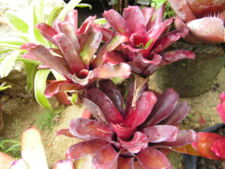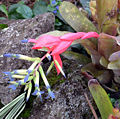Bromeliads
Bromeliaceae (the bromeliads) is a family of monocot flowering plants of around 2,400 species native mainly to the tropical Americas, with a few species found in the American subtropics and one in tropical west Africa. more...
The family includes both epiphytes, such as Spanish moss Tillandsia usneoides, and terrestrial species, such as the pineapple Ananas comosus. Many bromeliads are able to store water in a "tank" formed by their tightly-overlapping leaf bases. However, the family is diverse enough to include the tank bromeliads, grey-leaved epiphytic Tillandsia species which gather water only from leaf structures called trichomes, and a large number of desert-dwelling succulents.
The largest bromeliad is Puya raimondii, which reaches 3–4 m tall in vegetative growth with a flower spike 9–10 m tall, and the smallest is probably Spanish moss.
History
Bromeliads are one of the more recent plant groups to have emerged, presumed to have evolved at the close of the Cretaceous, over 65 million years ago. Fossilized bromeliads have been dated back to roughly 30 million years ago. The greatest number of primitive species reside in the Andean highlands of South America suggesting a beginning there. The west African species Pitcairnia feliciana is the only bromeliad not endemic to the Americas, and is thought to have reached Africa via long-distance dispersal approximately 12 million years ago.
Humans have been using bromeliads for thousands of years. The Incas, Aztecs, Maya and others used them extensively for food, protection, fiber and ceremony, just as they are still used today. European interest began when Spanish conquistadors returned with pineapple, which became so popular as an exotic food that the image of the pineapple was quickly adapted into European art and sculpture. In 1776, the species Guzmania lingulata was introduced to Europe, causing a sensation among gardeners unfamiliar to such a plant. In 1828, Aechmea fasciata was brought to Europe, followed by Vriesea splendens in 1840. These transplants were successful enough that they are still among the most widely grown bromeliad varieties.
In the 1800s breeders in Belgium, France and the Netherlands started hybridizing plants for wholesale trade. Many exotic varieties were produced up until the First World War which halted breeding programs and led to the loss of some species. The plants experienced a resurgence of popularity after World War II. Since then, Dutch, Belgian and North American nurseries have largely expanded bromeliad production.
Description
Bromeliads are a widely varied group of organisms, adapted to a number of climates. Foliage takes many different shapes, from needle thin to broad and flat, symmetrical to irregular, spiky and soft. The foliage, which usually grows in a rosette, is the most widely patterned and colored of any plant in the world. Leaf colors range from maroon, through various shades of green, to gold, with many colors in between. Many varieties have variegated leaves with red, yellow, white and cream variegations. Others may be spotted with purple, red, or cream, while others have different colors on the tops and bottoms of the leaves.
Read more at Wikipedia.org




